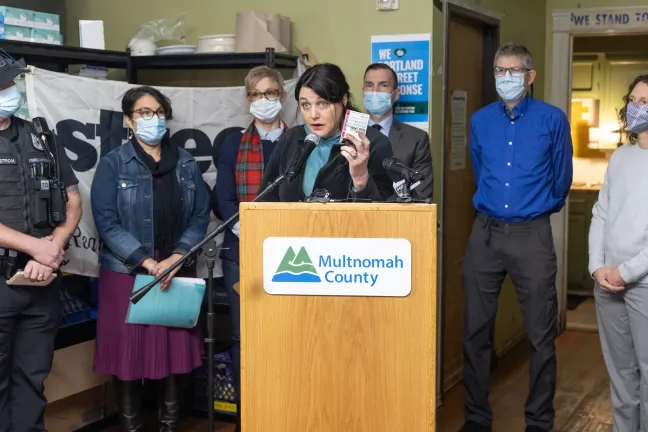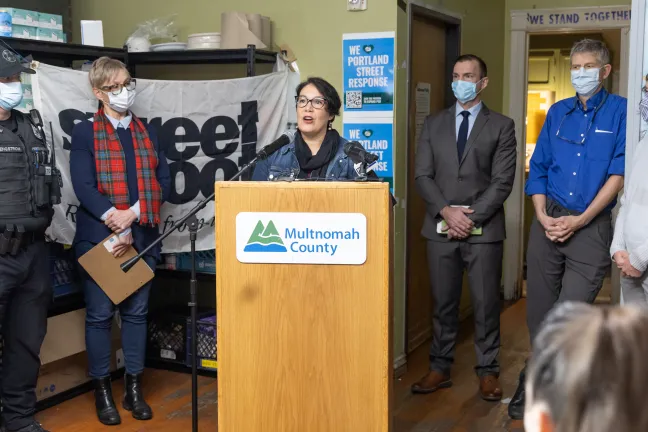The Multnomah County Health Department’s annual review of deaths among people experiencing homelessness has found that during calendar year 2022, at least 315 people died without a home of their own. The number counted in 2022 is the highest since Multnomah County began its analysis, in part because a new data source was added this year.
For the first time, the total includes both the accidental or suspicious deaths investigated by the Multnomah County Medical Examiner — 249 — as well as the deaths of 66 people who died at the hospital or under medical care and whose deaths were tallied from death certificates recorded by funeral homes. Hospital and medical care deaths numbers were included after Senate Bill 850 established mandatory reporting of housing status at death.
Because the County has long tracked deaths investigated by the Medical Examiner — the first jurisdiction in the state to do so — it can chart changes in that subset year over year. The 249 deaths in 2022 investigated by the Medical Examiner is up from 193 deaths in 2021. Medical Examiner deaths among people experiencing homelessness have jumped 29% on average every year between 2018 and 2022 — although that average is affected by larger increases recorded during and since the COVID-19 pandemic.
Deaths among the entire population of Multnomah County also rose in 2022. But the risk of an unhoused person dying a preventable death is starkly obvious. People experiencing homelessness were 45 times more likely to die from a transportation-related injury, 37 times more likely to die from a drug overdose, 32 times more likely to die from homicide, 18 times more likely to die from suicide and six times more likely to die from any cause compared to the general population.
Each year Multnomah County undertakes the Domicile Unknown report in partnership with Street Roots to determine the number, characteristics and causes of deaths among people experiencing homelessness in Multnomah County. Domicile Unknown is intended to help the public, elected officials and social service providers identify resources and policies that can save lives.
Since the Multnomah County Health Department and Medical Examiner began tracking deaths among people who were homeless in 2011, at least 1,274 people have died while unhoused.
The findings in this report direct policy decisions and guide efforts by the County Chair, County departments and the Joint Office of Homeless Services. In recent years, and all the way through the past several weeks, County officials have worked to expand shelters — including day shelters and services — respond more effectively to severe weather, coordinate plans across the homeless response system and behavioral healthcare to better address fentanyl and polysubstance use, and collaborate more closely with jurisdictions including the City of Portland, east County cities and neighboring counties.
“The raw and human costs of this crisis are moving in the wrong direction,” said Chair Jessica Vega Pederson. “The loss of these lives is beyond humbling, and today we sit with the full weight of these losses as a County and a community. Drug overdoses, traffic fatalities, and homicides were major contributors, and our homelessness response system must become more coordinated and effective to address these issues and reverse these trends. People’s lives depend on it.”
Leading causes of death
Of the at least 315 people who died while experiencing homelessness in 2022, 245 — 78% — were people assigned male at birth, and 70 — 22% — were people assigned female at birth. Their average age was 49 — 30 years younger than the age at which the average County resident might expect to die.
The largest proportion of deaths — 144 — were accidental or unintentional, and 85% of those were from drug overdoses. Most people had a combination of drugs in their system, but the most common substances were methamphetamine, and opioids, mainly fentanyl.
Of the 123 deaths associated with drug or alcohol toxicity, methamphetamines caused or contributed to 100 of those deaths, or 81% of all drug- or alcohol-related homeless deaths.
Fentanyl caused or contributed to 74 deaths among people experiencing homelessness in 2022 — more than double the number the year before and a sign of how rapidly the risk of overdose from the synthetic opioid has emerged. In the five years since fentanyl was first recorded as contributing to a death, one person died in 2017, two died in each of the following years, followed by four in 2020, and then 36 in 2021.
The increase in fentanyl-related deaths among people experiencing homelessness aligns with national trends, especially in the western United States, where fentanyl has become increasingly available.
Kaia Sand, executive director of Street Roots, encouraged people to carry naloxone — the opioid overdose-reversing medication that’s available over-the-counter — to help prevent fentanyl-related deaths. "Fentanyl deaths are preventable. People don't have to die hiding,” she said.
Traffic crashes
Traffic deaths made up the second-largest number of accidental deaths, with 14 people dying from crashes, or 10% of all unintentional deaths. That also mirrors a national trend in which pedestrian deaths reported by the U.S. Department of Transportation have increased every year for the past five years.
For the three families who participated in this year’s report, each lost a loved one who was walking along or crossing one of the region’s most traveled arterials: John Ellstrom walked on the Morrison Bridge, Jeremy Hofmann walked on Highway 99 East and Angela C. Boyd crossed Powell Boulevard.
The Portland Police Bureau’s Traffic Division is still investigating the hit-and-run that killed Boyd in April 2022, and her family is offering a monetary reward to anyone who provides information leading to the arrest and prosecution of the perpetrator.
Physical evidence found at the scene and surveillance footage indicate the vehicle involved in the crash was a dark gray Subaru Crosstrek with oversized wheels, black rims, tinted windows and a rooftop carrier. Sgt. Ty Engstrom of the Portland Police Bureau encouraged people with any information about the crash to submit it through Crime Stoppers of Oregon.
“In recent years, we've been horrified by the marked rise in traffic fatalities — especially deaths of people while walking, while experiencing homelessness, and young people. This public health epidemic is preventable but only with timely attention and action from the government at every level, said Sarah Iannarone, director of The Street Trust, which works to make streets safer for the most vulnerable people.
“The issue may seem complex, but at the core, it’s quite simple: speed, impairment and distraction contribute to over 90% of vehicle crashes in the U.S., and we have the power locally and with the help of the state to take immediate action and make lasting investments to save lives.”
Vega Pederson said the Joint Office of Homeless Services will begin distributing reflective gear to people experiencing homelessness. “We’ve got to make sure people are safer and more visible when they’re getting from here to there. Which is why our team at the Joint Office is working on distributing gear that includes reflective material — to help people stay seen and stay safe, especially at night when most of these fatalities occur.”
Homicide and Self-harm
Twenty-five people were killed while experiencing homelessness in 2022, the largest number of homicides since Multnomah County began producing Domicile Unknown in 2011, mirroring the increase in homicides among the population overall reported by the Portland Police Bureau. Seventeen people died by suicide, more than double the reported number from 2021.
Weather and deaths by month
On average, 26 people died each month, with the fewest dying in June — 18 — and the most in November, when 42 people died. One person died of heat, in July, and two others died of cold, one in November and another in December.
Chronic and communicable diseases
While drug overdoses, traffic injuries and homicides were major factors, people experiencing homelessness also died of chronic disease, such as heart disease, and communicable diseases, including COVID-19.
“My specialty is preventative medicine — these are preventable deaths,” said Multnomah County health officer Paul Lewis.
Housing and shelter — as well as the social, economic and environmental factors that underlie the causes of excess deaths among people experiencing homelessness — must continue to be considered to develop policies that can save lives and prevent premature death.
"Lack of affordable housing fuels addiction, untreated illness, overdoses and death on our streets,” said Bryan Guiney, director of the Oregon field office of the U.S. Department of Housing and Urban Development. "In spite of the challenges we face in solving unsheltered homelessness, we do have one thing going for us that few other vexing social problems have: We know what works. We know that housing works to solve homelessness.”
Vega Pederson said the lives lost last year underscore the urgency needed to respond to the homelessness crisis. "The best way to honor the 315 lives we lost in 2022 is to change our response to this crisis with the commitment, urgency and collaboration required. That has been my focus since Day One of coming into this office, and I’m here to tell you Multnomah County’s response to this crisis is changing,” she said.“We need more shelter. So we’re expanding and increasing coordination of our shelter response — including new day shelters to make sure people have places to stay safe at all hours of the day and night,” she said. “We’re increasing outreach to all populations — including those toughest to house — through the direct, on-the-ground connections made through Housing Multnomah Now, our Behavioral Health Resource Center and our partnership with the city’s TASS sites.”
Vega Pederson also outlined steps she is taking to help address the community’s growing fentanyl crisis. “We need places for people to go when they’re ready to detox or stabilize. We need more treatment options. And we need to make sure our outreach offers not only shelter but behavioral health resources,” she said. She pointed to recent investments the County has made toward these efforts, including $6.8 million for a 24/7 stabilization center for people leaving withdrawal management or sobering and $7 million for recovery-oriented housing.
“We can, and must, keep finding policy fixes. We can, and must, keep fighting for people to stay alive,’’ Sand said.
“But the fact that a person dies of homelessness almost every day in Multnomah County is an indictment of something deeper, societal, and national. It is an indictment of the systems and safety nets that break and fray, or never even exist at all, leaving people to end up on our streets.”



